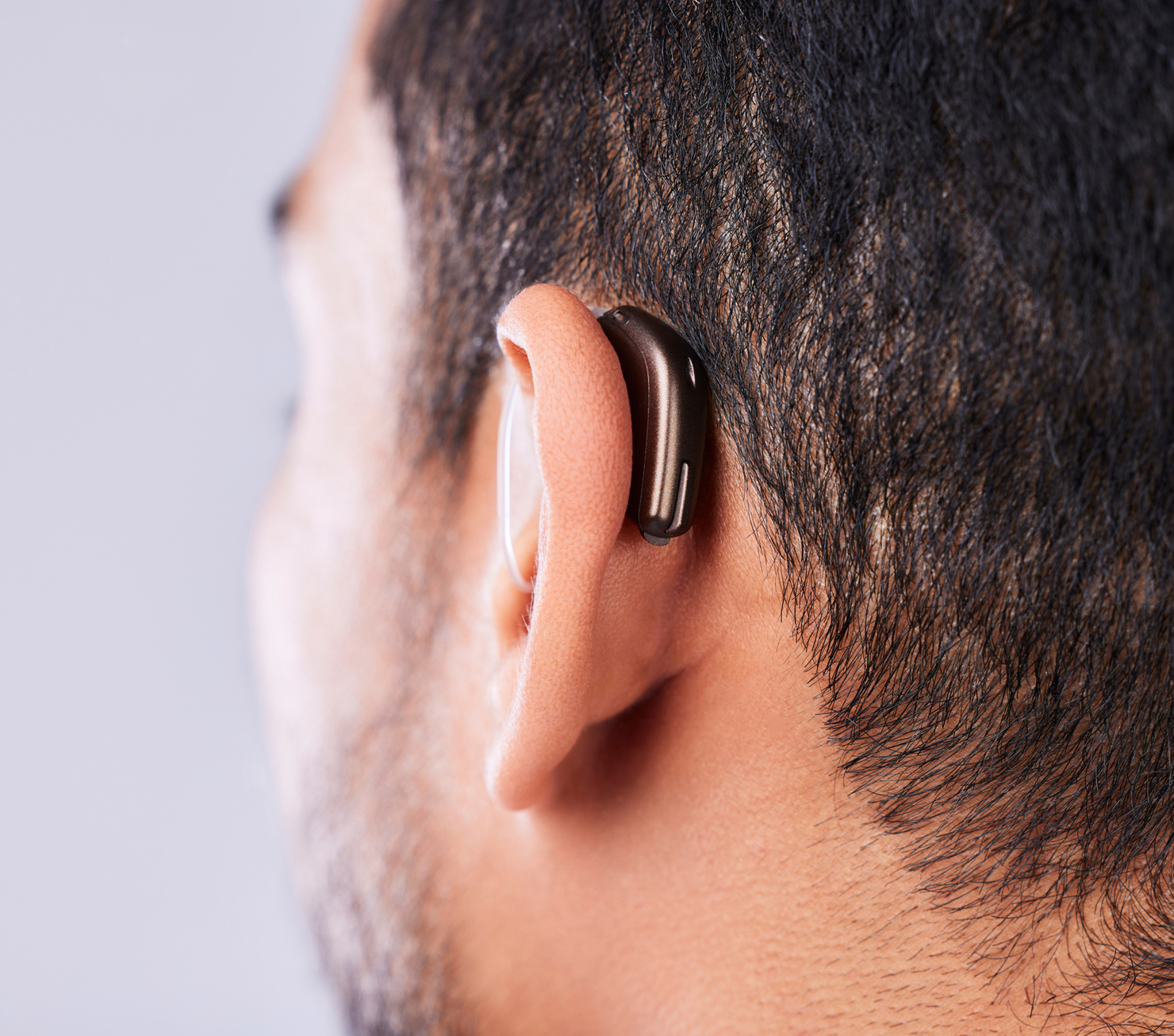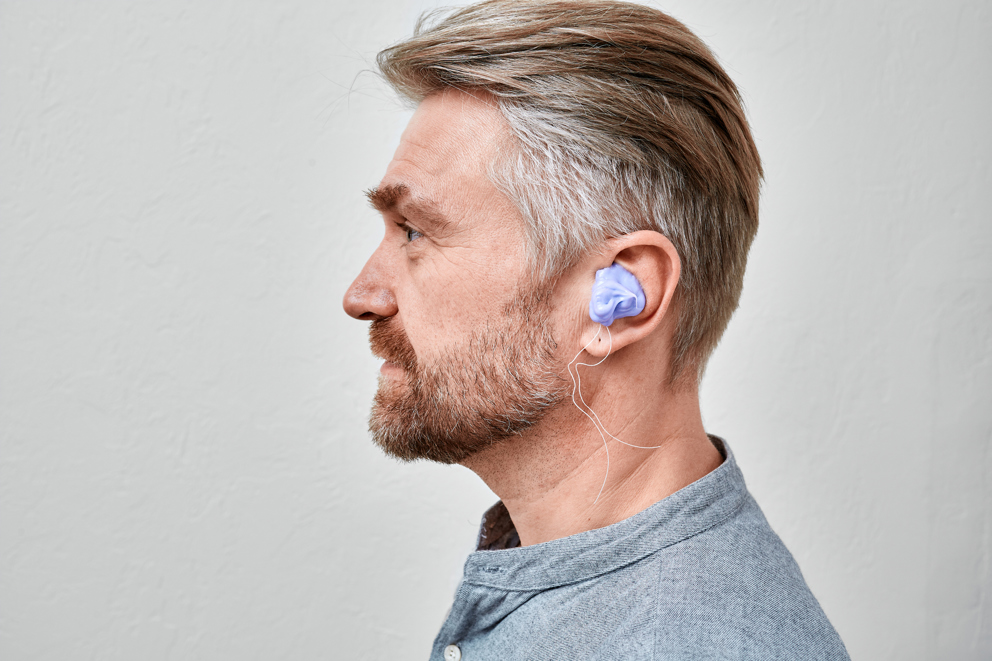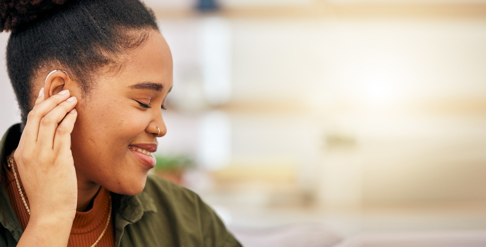
Co-Author: Leon-Vincent Fonai
What is Acoustic Coupling?
Acoustic coupling typically refers to the method by which sound waves are transmitted from a hearing aid speaker into the ear canal. This can be achieved through various means, such as ear molds or domes that fit tightly in the ear to improve the efficiency of sound transfer and reduce the intrusion of ambient noise.
Some patients with hearing aids may need acoustic coupling to help enhance sounds through their devices. If acoustic coupling is warranted, try putting a specific dome over the hearing aids’ cable and speaker to “seal off” the ear canal and eliminate excess background noise. Many audiologists use acoustic coupling to improve patients’ success with their hearing aids.
The specific domes associated with acoustic coupling have different acoustic effects. For instance, a dome with many openings or “gaps” lets more air flow through. But, if air can flow through, so can excess noise. Typically, the more you can seal off the ear canal, the better.
In general, higher-end hearing aids help people hear speech better, particularly in situations with background noise. However, even with these higher-end devices, some people can’t hear well if the hearing aids – and their ear canals – aren’t “sealed off” to block ambient noise, thus “forcing” sounds to go through the hearing aids more effectively. This allows the patient to better experience the hearing aids’ value and appreciate the investment they’ve made in the devices.
Acoustic Coupling & Acoustic Occlusion

Some people may find that when they “seal off” their ear canal, known as occlusion, they experience “intense and weird” vibrations – especially with their own voice – that might seem strange at first, but many people get used to this with time.
If a dome feels “too tight” and the sounds are too intense, the patient won’t be comfortable or happy with their devices. Therefore, try different domes with different openings to find something more comfortable. Consider that there are only a select number of “off the shelf” dome options, but millions of ears in all shapes and sizes.
Often, the best and easiest solution is to create custom earmolds to fit precisely. This way, you can select exactly the kinds of vents the patient needs, sealing as much as possible without making it too occluded, allowing the patient to get maximum benefits. The patient can use the features they need – like noise reduction – while avoiding problems like intense sounds and annoying vibrations that they hear acoustically, like a little “echo”.
However, it's important to note that not everyone is a candidate for acoustic coupling. Patients with normal low-frequency hearing may find the feel of an occluded dome or earmold uncomfortable, as it can make them feel plugged up. As a hearing care professional, you can determine if acoustic coupling is suitable for your patient based on their hearing profile and preferences. This tailored approach ensures that each patient can enjoy the benefits of their hearing devices comfortably.
Explaining Acoustic Coupling to Patients

Show patients their audiogram, a visual way to demonstrate their hearing test results. Commonly, people with hearing loss can hear low frequency sounds better than high frequencies, which can be shown graphically on the audiogram.
Suppose a patient buys high-end hearing aids, and you want them to get the maximum benefit from noise reduction. You fit them with a dome that has multiple open holes for ventilation, and when the air comes in, so does noise. The patient has invested significant money in these hearing aids and comes back to your clinic, frustrated, because they’re still hearing background noise, and having trouble hearing conversations, especially in loud environments. They’re upset that they’ve spent considerable money on the devices, yet they don’t feel like the hearing aids are working well for them.
You turn to acoustic coupling, sealing off this patient’s ear canals with domes. This forces the sound to go through the hearing aids, as there are no other openings for sound to enter. Now, the patient benefits from the hearing aids’ technology, which reduces the background noise and allows them to better hear speech and conversations, even in noisy environments. The patient feels like they’re getting more value from the expensive devices, and they feel happier and more satisfied with their hearing aids – and their experience with your clinic.
Benefits of Ideal Acoustic Coupling
-
Proper acoustic coupling can help reduce feedback, increase sound clarity, eliminate sound distortions, and help users hear high-frequency sounds with better clarity. Acoustic coupling can also reduce the feedback or “whistling sounds” that hearing aids sometimes make. Occasionally, when hearing aids try to amplify sounds, the sounds come out of the speaker inside the ear canal, causing feedback or whistling because the flat eardrum reflects and absorbs the sounds.
In these cases, the amplifications can be “too open,” causing feedback. It’s like attending a live stand-up comedy show when the comedian is standing too close to the microphone, so when they speak, there’s distracting “feedback” from the speaker. If the comic increases the distance between the microphone and the speaker, it immediately eliminates the problem. In the case of the hearing aids, you can’t increase the distance – since the device needs to go into the patient’s ear – the solution is to seal up the ear canal to “put up a barrier” between the speaker and the microphone to eliminate the feedback. -
The right fit improves comfort, which can increase user satisfaction and device usage. Acoustic coupling can help improve fit, especially when you provide custom earmolds for your patients. Also, acoustic coupling can help eliminate things that patients may find annoying, such as feedback, making the devices more comfortable. This often leads to increased wear time, and higher customer satisfaction, happiness, loyalty, and retention.
-
Appropriate acoustic coupling minimizes occlusion, making the hearing aid experience more pleasant. Some patients become frustrated by their own voice sounding too intense when domed, causing them to not want to wear their hearing aids. To resolve this issue, create a deeper dome that goes past where the jawbone presses the ear canal. Then, make a nugget earmold, or a deeply placed custom earmold, that goes past or behind the jawbone. Create a cutout so the bone isn’t touching the earpiece at all, which reduces (or eliminates) the vibrations. The nugget earpiece is an exciting way of accomplishing this.
The shark bite cutout accomplishes the same thing. As the name implies, the shark bite has a jagged look, like a shark took a bite out of it. Use the shark bite like the nugget, to avoid having the jawbone connect with the earpiece. This helps reduce vibrations from the sound of the user’s voice, as well as other body sounds that might annoy the patient, like the sounds of their blood rushing, chewing, etc. The nugget and shark bite can help patients resolve these potentially irritating sounds, so they can better adapt to wearing their hearing aids and have more successful outcomes.
Challenges in Achieving Ideal Acoustic Coupling

Feedback
If the patient is experiencing feedback or whistling, the solution could be as simple as sealing off the ear more. Try fitting the patient with a dome or custom earpiece with less ventilation – which means less sound can enter or exit the ear canal – and see if that solves the problem. It’s mainly sound exiting the ear canal that causes feedback.
Discomfort
Some patients may experience discomfort from physical pressure of the hearing aids, earpieces, and/or dome pressing against their ears. Try gently filing or scraping off the parts with a drilling machine to relieve the pressure and discomfort. In some cases, the customers are just not used to the sensation of the earpieces or the occlusion and – if it’s not physically painful – might just need a little time to get used to the new sensations. It may be helpful to reiterate the benefits and value of acoustic coupling and encourage them to get used to it. If the patient still expresses continued discomfort, take the earpiece and drill off the area where the bone touches to create a nugget or shark bite. Encourage the patient to try the adjusted devices for a few more days to see if the cutouts improve their comfort level.
Performance
Some patients experience decreased efficiency with their hearing aids’ adaptive functions and features. For instance, they may experience problems with directionality, like not having it focus correctly in certain directions, not reducing background noise properly, etc. If the dome is too open, some features may not perform correctly. In these cases, the dome may need to be sealed off more.
If the patient notices signs of poor acoustic coupling – like they bought a high-end device, but the noise reduction is barely noticeable – they should contact your clinic for assistance and troubleshooting.
Strategies for Optimizing Acoustic Coupling

Just like hearing aids, acoustic coupling isn’t a “one size fits all” solution. Clinicians must work closely with each patient to find the right approach to optimize their hearing, comfort, and experience. Here are some best practice strategies:
Customize and Fit Earmolds
Since ear canals come in so many shapes and sizes, it can be very beneficial to create customized earmolds for your patients and conduct professional fitting sessions. Having the proper fit leads to increased comfort, improved hearing, and patients wearing their hearing aids (and being happy with them). Doing this step properly is crucial. Custom fit earmolds usually help clients with reduced dexterity put in their devices, as well. This helps ensure they actually wear them.
Conduct Regular Assessments and Adjustments
Recommend (and conduct) regular check-ups to ensure the coupling remains ideal as the user's needs – and the condition of the hearing aids – change over time. Use your clinic’s Practice Management Software to schedule regular appointments, send out automatic appointment reminders, and stay in contact with your patients throughout the year.
Educate Your Patients
Educate your patients about acoustic coupling, including the signs of poor acoustic coupling and when to seek help. For instance, if they bought a high-end device, but the noise reduction is barely noticeable, they should call your clinic for an appointment to resolve the problem. Also, if they’re experiencing frustrations or annoyances – like the sound of their own voice or chewing feels “too intense” – they might be good candidates for the nugget or shark bite, which creates space between the earpiece and their jawbone, to reduce or eliminate the excess vibrations causing the intensity. Post consumer education information about acoustic coupling on your website and social media platforms, including frequently asked questions, information on troubleshooting, when to call your clinic, etc. Additionally, provide patients with handouts, brochures, and/or email content about acoustic coupling as part of their customer journey with your clinic.
Technological Advances Aiding Acoustic Coupling

There have been some exciting design and material innovations that have improved acoustic coupling – and have helped advance the audiology industry and hearing care, in general.
New materials
Exciting new materials – including ThermoTec or VarioTherm – are game changers in the audiology space. When custom earpieces made of these materials are out in the air, they’re stiff and easier to handle or put inside the ear, but once they’re inserted into a patient’s ear, the earpieces adjust and adapt to the patient’s body temperature and hug the ear very well. Some users say these materials are more comfortable than other types of domes that have previously been used for acoustic coupling. Keep in mind that more traditional acrylic materials have been shown to be better for people with allergies – vs. some of these new materials – because the smooth acrylic surfaces are easier to keep clean. Vario is more porous, which means it can be prone to attracting more bacteria.
Another trend in audiology checks a few important boxes. Gold and titanium – materials that are becoming more common in hearing aids and earpieces for acoustic coupling – help reduce the perceived stigma that hearing aids make people “look old”. The gold and titanium materials are more stylish and hipper, offering a “tech vibe” that’s appealing to younger demographics. Gold and titanium also have the added benefit of being hypoallergenic.
New shape
The nugget shape is new, especially in European markets, like Germany, Austria, Switzerland and some eastern European countries. This is an effective method of reducing irritating sound vibrations through the jaw, which can be distracting and annoying for some patients, often causing them to discontinue using their hearing aids. This innovative approach is valuable, increasing hearing aid usage, comfort, positive outcomes, and patient satisfaction.
Other Blogs You Might Enjoy

What Do Your Hearing Aid Users Need?
If someone suspects they have hearing loss, they should see an audiologist for a hearing screening to determine whether they need hearing aids. But then what happens? This blog explains how to give your patients what they need for success with their hearing aids, such as setting proper expectations, providing care and maintenance tips for the devices, offering valuable tips before they buy, and providing ongoing aftercare.

How Auditdata Manage Helps You Deliver Best Care Experiences
Explore how Auditdata's Practice Management Software, Manage, enhances audiology care with advanced scheduling, personalized services, and effective aftercare. Learn to optimize every patient interaction to provide best care experiences to every patient at all times.

Customer vs. Patient – Does it Matter What You Call the People You Serve?
Should hearing clinics refer to the individuals they serve as patients or customers? Do these words matter? Could specific terminology make people feel better (or worse) about needing hearing aids? This blog explores the connotations associated with these terms.